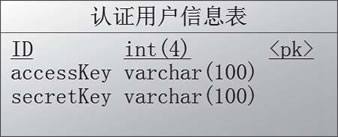Spring Cloud基于JWT创建统一的认证服务
认证服务肯定要有用户信息,不然怎么认证是否为合法用户?因为是内部的调用认证,可以简单一点,用数据库管理就是一种方式。或者可以配置用户信息,然后集成分布式配置管理就完美了。

图 1 用户表
相关的代码如下所示。
生成 Token 是在进行用户身份认证之后,通过用户的 ID 来生成一个 Token,这个 Token 采用 RSA 加密的方式进行加密,Token 的内容包括用户的 ID 和过期时间。
检查 Token 则是根据调用方带来的 Token 检查是否为合法用户,就是对 Token 进行解密操作,能解密并且在有效期内表示合法,合法则返回用户 ID。
刷新 RSA 公钥及私钥的作用是防止公钥、私钥泄露,公钥、私钥一般是写死的,不过我们可以做成配置的。集成配置管理中心后,可以对公钥、私钥进行动态修改,修改之后需要重新初始化公钥、私钥的对象信息。
获取 Token 代码如下所示。
由于篇幅有限,请大家继续阅读以下教程:
表结构
本教程中的案例把查数据库这一步骤省略了,大家可以自行补充,但是表的设计还是要跟大家讲解的。用户表的形式如图 1 所示。
图 1 用户表
相关的代码如下所示。
create table auth_user( id int(4) not null, accessKey varchar(100) not null, secretKey varchar(100) not null, Primary key (id) ); Alter table auth_user comment '认证用户信息表';这里只有简单的几个字段,若大家有别的需求可以自行去扩展。代码中的 accessKey 和 secretKey 是用户身份的标识。
JWT 工具类封装
JWT 的 GitHub 地址是:https://github.com/jwtk/jjwt,依赖配置代码如下所示。
<dependency>
<groupId>io.jsonwebtoken</groupId>
<artifactId>jjwt</artifactId>
<version>0.7.0</version>
</dependency>
- 生成 Token。
- 检查 Token 是否合法。
- 刷新 RSA 公钥以及私钥。
生成 Token 是在进行用户身份认证之后,通过用户的 ID 来生成一个 Token,这个 Token 采用 RSA 加密的方式进行加密,Token 的内容包括用户的 ID 和过期时间。
检查 Token 则是根据调用方带来的 Token 检查是否为合法用户,就是对 Token 进行解密操作,能解密并且在有效期内表示合法,合法则返回用户 ID。
刷新 RSA 公钥及私钥的作用是防止公钥、私钥泄露,公钥、私钥一般是写死的,不过我们可以做成配置的。集成配置管理中心后,可以对公钥、私钥进行动态修改,修改之后需要重新初始化公钥、私钥的对象信息。
获取 Token 代码如下所示。
/**
* 获取 Token
*
* @param uid 用户 ID
* @param exp 失效时间, 单位分钟
* @return
*/
public static String getToken(String uid, int exp) {
Long endTime = System.currentTimeMillis() + 1000 * 60 * exp;
return Jwts.builder().setSubject(uid).setExpiration(new Date(endTime))
.signWith(SignatureAlgorithm.RS512, priKey).compact();
}
检查 Token 是否合法代码如下所示。
/**
* 检查 Token 是否合法
*
* @param token
* @return JWTResult
*/
public JWTResult checkToken(String token) {
try {
Claims claims = Jwts.parser().setSigningKey(pubKey).parseClaimsJws(token).getBody();
String sub = claims.get("sub", String.class);
return new JWTResult(true, sub, "合法请求", ResponseCode.SUCCESS_CODE.getCode());
} catch (ExpiredJwtException e) {
// 在解析 JWT 字符串时, 如果'过期时间字段'已经早于当前时间,
// 将会抛出 ExpiredJwtException 异常, 说明本次请求已经失效
return new JWTResult(false, null, "token已过期 ", ResponseCode.TOKEN_TIMEOUT_CODE.getCode());
} catch (SignatureException e) {
// 在解析 JWT 字符串时, 如果密钥不正确, 将会解析失败, 抛出
// SignatureException 异常, 说明该 JWT 字符串是伪造的
return new JWTResult(false, null, "非法请求", ResponseCode.NO_AUTH_CODE.getCode());
} catch (Exception e) {
return new JWTResult(false, null, "非法请求", ResponseCode.NO_AUTH_CODE.getCode());
}
}
完整代码如下所示。
/**
* API调用认证工具类,采用RSA加密
*/
public class JWTUtils {
private static RSAPrivateKey priKey;
private static RSAPublicKey pubKey;
private static class SingletonHolder {
private static final JWTUtils INSTANCE = new JWTUtils();
}
public synchronized static JWTUtils getInstance(String modulus, String privateExponent, String publicExponent) {
if (priKey == null && pubKey == null) {
priKey = RSAUtils.getPrivateKey(modulus, privateExponent);
pubKey = RSAUtils.getPublicKey(modulus, publicExponent);
}
return SingletonHolder.INSTANCE;
}
public synchronized static void reload(String modulus, String privateExponent, String publicExponent) {
priKey = RSAUtils.getPrivateKey(modulus, privateExponent);
pubKey = RSAUtils.getPublicKey(modulus, publicExponent);
}
public synchronized static JWTUtils getInstance() {
if (priKey == null && pubKey == null) {
priKey = RSAUtils.getPrivateKey(RSAUtils.modulus, RSAUtils.private_exponent);
pubKey = RSAUtils.getPublicKey(RSAUtils.modulus, RSAUtils.public_exponent);
}
return SingletonHolder.INSTANCE;
}
/**
* 获取Token
*
* @param uid 用户ID
* @param exp 失效时间,单位分钟
* @return
*/
public static String getToken(String uid, int exp) {
long endTime = System.currentTimeMillis() + 1000 * 60 * exp;
return Jwts.builder().setSubject(uid).setExpiration(new Date(endTime))
.signWith(SignatureAlgorithm.RS512, priKey).compact();
}
/**
* 获取Token
*
* @param uid 用户ID
* @return
*/
public String getToken(String uid) {
long endTime = System.currentTimeMillis() + 1000 * 60 * 1440;
return Jwts.builder().setSubject(uid).setExpiration(new Date(endTime))
.signWith(SignatureAlgorithm.RS512, priKey).compact();
}
/**
* 检查Token是否合法
*
* @param token
* @return JWTResult
*/
public JWTResult checkToken(String token) {
try {
Claims claims = Jwts.parser().setSigningKey(pubKey).parseClaimsJws(token).getBody();
String sub = claims.get("sub", String.class);
return new JWTResult(true, sub, "合法请求", ResponseCode.SUCCESS_CODE.getCode());
} catch (ExpiredJwtException e) {
// 在解析JWT字符串时,如果‘过期时间字段’已经早于当前时间,将会抛出ExpiredJwtException异常,说明本次请求已经失效
return new JWTResult(false, null, "token已过期", ResponseCode.TOKEN_TIMEOUT_CODE.getCode());
} catch (SignatureException e) {
// 在解析JWT字符串时,如果密钥不正确,将会解析失败,抛出SignatureException异常,说明该JWT字符串是伪造的
return new JWTResult(false, null, "非法请求", ResponseCode.NO_AUTH_CODE.getCode());
} catch (Exception e) {
return new JWTResult(false, null, "非法请求", ResponseCode.NO_AUTH_CODE.getCode());
}
}
public static class JWTResult {
private boolean status;
private String uid;
private String msg;
private int code;
public JWTResult() {
super();
}
public JWTResult(boolean status, String uid, String msg, int code) {
super();
this.status = status;
this.uid = uid;
this.msg = msg;
this.code = code;
}
public int getCode() {
return code;
}
public void setCode(int code) {
this.code = code;
}
public String getMsg() {
return msg;
}
public void setMsg(String msg) {
this.msg = msg;
}
public boolean isStatus() {
return status;
}
public void setStatus(boolean status) {
this.status = status;
}
public String getUid() {
return uid;
}
public void setUid(String uid) {
this.uid = uid;
}
}
}
认证接口
认证接口用于调用方进行认证时,认证通过则返回一个加密的 Token 给对方,对方就可以用这个 Token 去请求别的服务了,认证获取 Token 代码如下所示。
@PostMapping("/token")
public ResponseData auth(@RequestBody AuthQuery query) throws Exception {
if (StringUtils.isBlank(query.getAccessKey()) || StringUtils.isBlank(query.getSecretKey())) {
return ResponseData.failByParam("accessKey and secretKey not null");
}
User user = authService.auth(query);
if (user == null) {
return ResponseData.failByParam(" 认证失败 ");
}
JWTUtils jwt = JWTUtils.getInstance();
return ResponseData.ok(jwt.getToken(user.getId().toString()));
}
认证参数代码如下所示。
/**
* API 用户认证参数类
*/
public class AuthQuery {
private String accessKey;
private String secretKey;
// get set ...
}
AuthService 中的 auth 方法就是根据 accessKey 和 secretKey 判断是否有这个用户。由于篇幅有限,请大家继续阅读以下教程:
所有教程
- C语言入门
- C语言编译器
- C语言项目案例
- 数据结构
- C++
- STL
- C++11
- socket
- GCC
- GDB
- Makefile
- OpenCV
- Qt教程
- Unity 3D
- UE4
- 游戏引擎
- Python
- Python并发编程
- TensorFlow
- Django
- NumPy
- Linux
- Shell
- Java教程
- 设计模式
- Java Swing
- Servlet
- JSP教程
- Struts2
- Maven
- Spring
- Spring MVC
- Spring Boot
- Spring Cloud
- Hibernate
- Mybatis
- MySQL教程
- MySQL函数
- NoSQL
- Redis
- MongoDB
- HBase
- Go语言
- C#
- MATLAB
- JavaScript
- Bootstrap
- HTML
- CSS教程
- PHP
- 汇编语言
- TCP/IP
- vi命令
- Android教程
- 区块链
- Docker
- 大数据
- 云计算